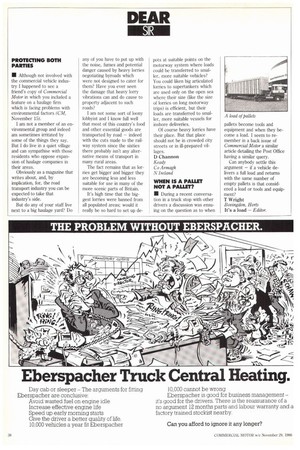DEAR
Page 40

If you've noticed an error in this article please click here to report it so we can fix it.
SIR
PROTECTING BOTH PARTIES • Although not involved with the commercial vehicle industry I happened to see a friend's copy of Commercial Motor in which you included a feature on a haulage firm which is facing problems with environmental factors (CM, November 15).
I am not a member of an environmental group and indeed am sometimes irritated by some of the things they say. But I do live in a quiet village and can sympathise with those residents who oppose expansion of haulage companies in their areas.
Obviously as a magazine that writes about, and, by implication, for, the road transport industry you can be expected to take that industry's side.
But do any of your staff live next to a big haulage yard? Do any of you have to put up with the noise, fumes and potential danger caused by heavy lorries negotiating byroads which were not designed to cater for them? Have you ever seen the damage that heavy lorry vibrations can and do cause to property adjacent to such roads?
I am not some sort of loony lobbyist and I know full well that most of this country's food and other essential goods are transported by road — indeed with the cuts made to the railway system since the sixties there probably isn't any alternative means of transport in many rural areas.
The fact remains that as lorries get bigger and bigger they are becoming less and less suitable for use in many of the more scenic parts of Britain.
It's high time that the biggest lorries were banned from all populated areas; would it really be so hard to set up de pots at suitable points on the motorway system where loads could be transferred to smaller, more suitable vehicles? You could liken big articulated lorries to supertankers which are used only on the open sea where their size (like the size of lorries on long motorway trips) is efficient, but their loads are transferred to smaller, more suitable vessels for inshore deliveries.
Of course heavy lorries have their place. But that place should not be in crowded city streets or in ill-prepared villages.
D Channon Keady Co Armagh N Ireland WHEN IS A PALLET NOT A PALLET?
• During a recent conversation in a truck stop with other drivers a discussion was ensuing on the question as to when A load of pallets
pallets become tools and equipment and when they become a load. I seem to remember in a back issue of Commercial Motor a similar article detailing the Post Office having a similar query.
Can anybody settle this argument — if a vehicle delivers a full load and returns with the same number of empty pallets is that considered a load or tools and equipment?
T Wright Bovingdon, Hats
It's a load — Editor.
























































































































